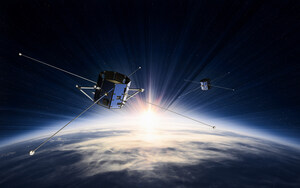EL SEGUNDO, Calif., Dec. 7, 2020 /PRNewswire/ -- Two Millennium Space Systems-built small satellites were successfully launched into low-Earth orbit last month – and the company's engineers, as well as the world's amateur satellite tracking community, now are watching them as they race back to Earth.
The two satellites, part of the DRAGRACER controlled flight experiment, are demonstrating and maturing deployable tether technology that enables low-Earth orbiting (LEO) satellites to return faster and more-reliably, and help safely lessen the growing problem of orbital debris congestion.
"We all are striving to be good stewards of the space environment," said Tom Russell, interim CEO of Millennium Space Systems. "DRAGRACER is part of our proactive support to being those good stewards. This experiment adds to the body of knowledge on a unique, yet credible, alternative solution to mitigate the orbital debris problem and it is applicable to all sizes and classes of LEO satellites."
The DRAGRACER satellites were launched Nov. 19 atop a Rocket Lab Electron launch vehicle in New Zealand. One satellite, called ALCHEMY, is equipped with a 70-meter Tethers Unlimited Terminator Tape that was unfurled in low-Earth orbit. The tether increases the surface area of the spacecraft and it is expected to sink and burn up as it falls from Earth's upper atmosphere in approximately 45 days. The other satellite, AUGURY, the control for the scientific experiment, is expected to follow a natural decay trajectory of between five and seven-and-a-half years.
Millennium Space Systems engineers are monitoring the telemetry of both satellites as they return to Earth and comparing flight data with predictive deorbit models. The amateur satellite tracking community can follow DRAGRACER's progress and provide data and images via a web portal.
The DRAGRACER mission is a collaborative effort of Millennium Space Systems, a Boeing subsidiary; Tethers Unlimited; mission launch service provider TriSept; and Rocket Lab.
"The population of space debris is already growing exponentially and, with numerous companies and government programs launching constellations of hundreds or thousands of satellites into low-Earth orbit, responsible stewardship of the orbital environment is crucial to ongoing use of space for commerce and defense," said Robert Hoyt, founder and president of Tethers Unlimited. "We are very excited and grateful for the opportunity to demonstrate our Terminator Tape as a cost-effective and low-mass solution for safe disposal of satellites at the end of their missions."
TriSept brokered the rideshare slot for the DRAGRACER mission spacecraft and led the integration of the payload aboard the launch vehicle. DRAGRACER marks TriSept's 71st space mission, as the firm has now enabled the launch of over 200 satellites aboard 20 different launch vehicles from 13 launch sites across the globe.
"The TriSept team is thrilled to have led the integration effort for this historic DRAGRACER mission," said Rob Spicer, TriSept CEO. "TriSept is committed to working with spacecraft manufacturers, technology partners, and government and commercial programs across the space industry in driving access to space for what are often game-changing missions such as DRAGRACER."
Media contact:
Tom Koehler, Boeing Communications
[email protected]
206-290-5367
SOURCE Millennium Space Systems

WANT YOUR COMPANY'S NEWS FEATURED ON PRNEWSWIRE.COM?
Newsrooms &
Influencers
Digital Media
Outlets
Journalists
Opted In




Share this article